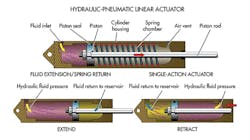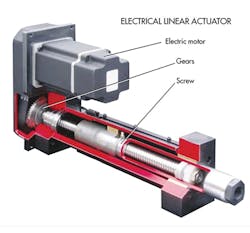It seems almost all industries use linear actuators in some way—perhaps to move inventory, products, or components, or to carry out manufacturing and assembly processes. They convert energy into a motion or force and are usually powered by one of three methods: hydraulics, pneumatics or electricity. Here’s a quick look at each of these methods.
Pneumatic Actuators
Pneumatic actuators have a piston inside a hollow cylinder that is moved through that cylinder by pressurized air entering from a compressor or pump. This linear motion can move a load or create a force. The piston returns to its original position using a spring or pressurized air supplied to the other side of the piston.
Most aluminum pneumatic actuators carry a maximum pressure rating of 150 psi. They are available in bore sizes from ½ to 8 in. and can create 7,500 lb. of force. For higher forces, steel actuators have a maximum pressure rating of 250 psi with bore sizes from ½ to 14 in. They generate from 50 to 38,465 lbf.
Advantages of Pneumatic Actuators
Accuracy. Pneumatic actuators routinely have positional errors of 0.1 in. and repeatability within .001 in.
Temperature resistance. Pneumatic actuators can withstand temperatures from −40°F to 250°F (−14°C to 120°C).
Safety. Pneumatic actuators do not use hazardous materials, so they pose no environmental or health hazards. They also do not use a motor so there is no possible magnetic interference, which lets them meet requirements for explosion protection and machine safety.
Low cost. The lightweight, durable actuators cost less than comparable hydraulic and electric versions. They also require little maintenance.
Disadvantages of Pneumatic Actuators
Compressed air. Pressure losses and air’s compressibility make pneumatics less efficient than hydraulics and electricity. Compressor and air delivery can limit operations with lower pressures, resulting in lower forces and speeds.
The compressor must run and provide operating pressure even if nothing is moving. And even though the air is easily available and free, it must be kept clean and at the proper humidity; if it gets contaminated by oil or lubrication, it will lead to downtime and maintenance. Compressed air is a consumable that must be paid for, and the air lines and compressor must be maintained.
Hard to upgrade. Pneumatic actuators must be sized for a specific job to be efficient; they cannot effectively be used for other applications. And if a factory wants to improve control and efficiency, technicians must install proportional regulators and valves—a costly and complex upgrade.
READ MORE - A Technical Comparison: Pneumatic Cylinders and Electric Rod Actuators
Hydraulic Acutators
Hydraulic linear actuators operate similarly to pneumatic actuators, but a pressurized incompressible liquid (hydraulic fluid) supplied by a pump rather than pressurized air moves the cylinder.
Advantages of Hydraulic Actuators
High force. Hydraulic actuators are rugged and well-suited for generating forces up to 25 times greater than those possible with equally sized pneumatic cylinders. They also have horsepower-to-weight ratios 1 to 2 hp/lb greater than a comparably sized pneumatic motor.
Brakes. Hydraulic actuators can hold a force and torque constant without the pump sending more fluid or pressure, thanks to the fluid’s incompressibility.
Flexible footprint. The pumps and motors needed by hydraulic actuators can be housed a considerable distance away from the actuators with minimal power loss.
Disadvantages of Hydraulic Actuators
Leaks. Hydraulics will leak, and fluid loss leads to less efficiency. Hydraulic fluid leaks lead to problems and potential damage to surrounding components and areas.
Complexity. Hydraulic actuators require lots of parts, including a fluid reservoir, motors, pumps, release valves and heat exchangers, along with noise-reduction equipment. This makes for large and difficult to accommodate linear motion subsystems.
Electric Actuators
Electric actuators convert electrical energy into torque that can then be turned into linear motion. For example, the motor could turn a thread lead or ball screw. A threaded lead or ball nut with threads matching the screw’s is prevented from rotating with the screw. So when the screw rotates, the nut gets moved along the threads. The direction the nut moves depends on which direction the screw rotates.
Advantages of Electric Actuators
Accuracy. Electric actuators offer the most precise control; they have accuracies of ±0.000315 in. and repeatability below 0.0000394 in. They can be scaled for any purpose or force requirements.
Programmable. Electric actuators can be networked and reprogrammed quickly, letting operators preset or adjust velocity, position, torque, and applied force.
They also supply immediate feedback for diagnostics and maintenance.
Noise. They are quieter than pneumatic and hydraulic actuators.
Clean. There are no fluids in electric actuators (except perhaps for lubrication), so environmental hazards are minimal.
READ MORE: Getting the Right Stepper or Servo Motor for Electric Actuators
Disadvantages of Electric Actuators
Cost. The initial cost of an electrical actuator is higher than those for pneumatics and hydraulics.
Setup. Electric actuators are not suited for all environments. For example, unlike pneumatic actuators, they are not safe in hazardous and flammable areas. The motor can also be large, creating installation problems.
Overheating. Continuously running motors tend to overheat, increasing wear-and-tear on the reduction gear.
Difficult to upgrade. The motor chosen locks in the actuator’s force, thrust, and speed limits. If a different set of values for force, thrust and speed is desired, the motor must be replaced.
This article appeared in Machine Design, an affiliate publication to Power & Motion.
About the Author

Leaders relevant to this article:


